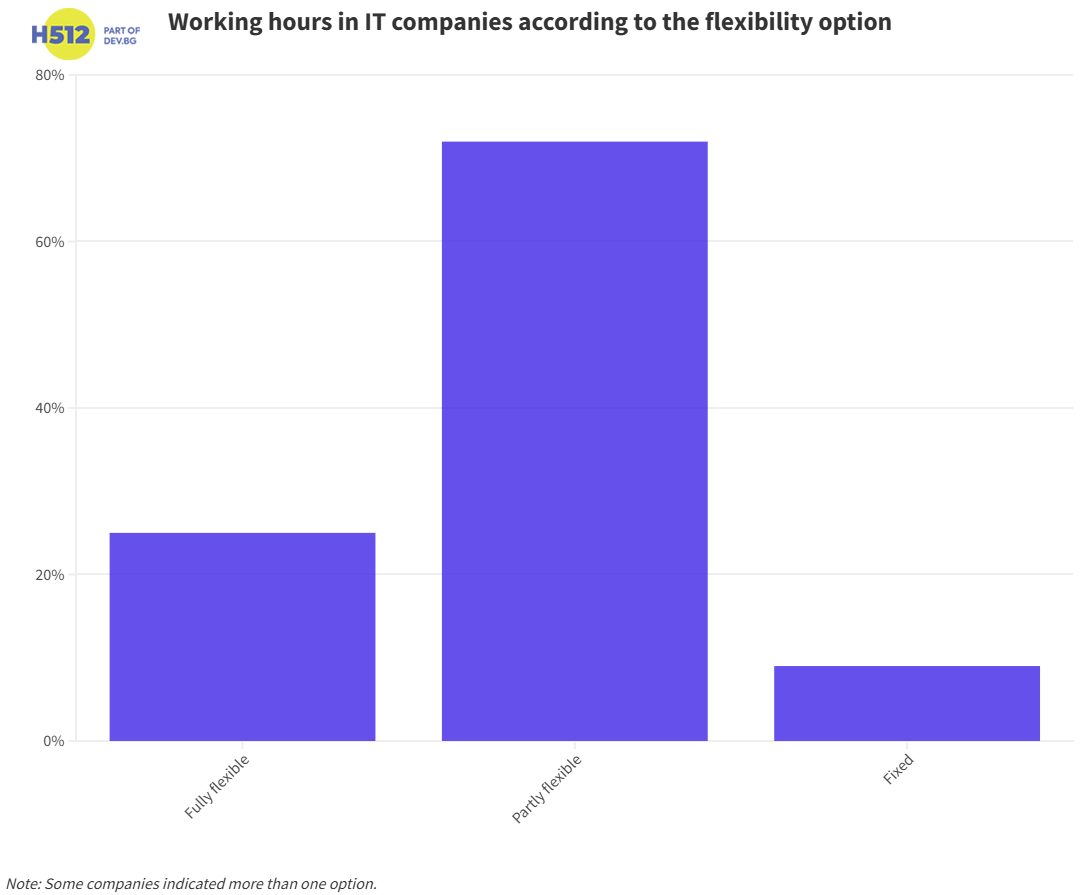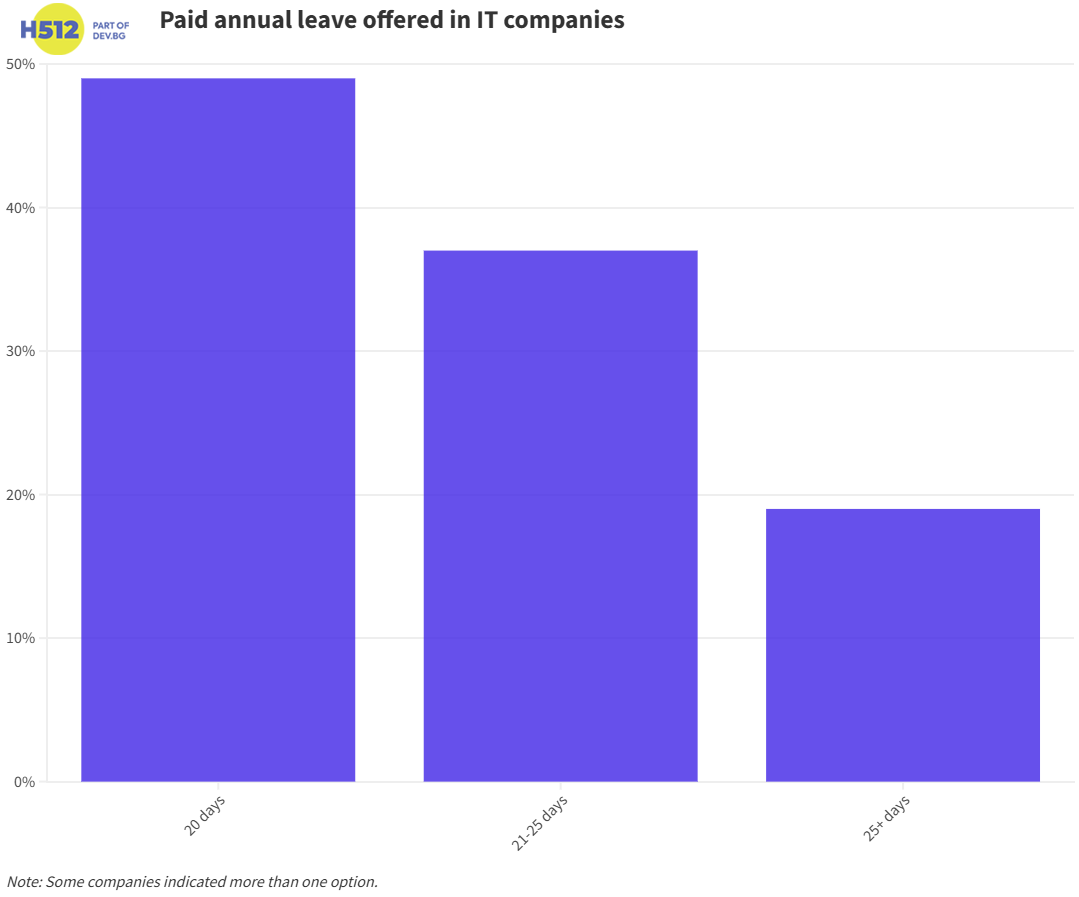Another working day begins. Last night Anna had a hard time sleeping, and today she wakes up from her fourth alarm and again it takes a whole hour to get out of bed and head to the office. She is often nervous during meetings with colleagues, sometimes has a headache and is not particularly motivated to complete the project she is currently working on as team lead. Anna is not yet aware but is probably facing a burnout. And anyone could be in her place.
To avoid such conditions in their employees, IT companies are looking for ideas and ways to deal with the difficulties that teams may have to go through amid the need for fast-paced work and its volumes. That’s why all of the 1,500+ companies on H512.com’s Job Board offer options related to people well-being.
According to our data* this often includes flexible working – in most IT offices full and/or partial flexi-time is allowed, while fixed hours are seen less frequently. Thus, most professionals have greater freedom to adjust work duties to suit their most productive hours and their personal lives.

Half of the companies in the IT sector now also offer longer than the standard 20 days leave per year. 19% allow more than 25 days off, while so-called sabbatical or creative leave is still not as common according to our Job Board. Only two companies have listed it as an option.

Homeoffice is also eligible for most IT companies. Only 6.5% of them do not allow it, and in some of these cases the reason is that the projects require a physical presence. Some of the most touted benefits of it are higher productivity, a more personalized work environment, and the ability to avoid commuting into the city during the busiest hours.

Telecommuting is also something sought after by IT professionals themselves according to a survey** on our Job Board. For as many as 94%, it’s important that the company they apply to offers home office.
With the advent of homoffice as a perk, the lines between personal and work space have begun to cross, and this was felt even more strongly during the pandemic. ADP Research Institute data for 2021 shows that employees then performed a total of more than one day of work each week, or 8.5 hours of unpaid overtime, compared to 7.3 hours in the pre-pandemic period.
“An awful lot of people had trouble locating work as space, time and boundaries relative to everything else going on in their lives,” says Atanas Ganchev of the Time and Space Psychology Center .
According to a Future Forum survey, by early 2023, 42% of respondents globally indicated that they had gone through a burnout, peaking from 2021, when the platform began keeping statistics on the topic. Two groups are at greater risk of burnout – employees under the age of 30 and women.
“Usually people who are in more severe states of burnout have a desperate state of mind. They feel that they are at an impasse, that they are severely dissatisfied. They habitually have negative and depressing emotions for quite some time, but ignore them. There is no person who feels severely depressed. It’s a process that builds up and is ignored and dulled in some way for a long time,” says Ganchev, who is a clinical psychologist.
Explore more
The World Health Organization defines burnout as a syndrome that occurs as a result of chronic stress in the workplace, and it has three dimensions:
- A feeling of depleted energy or exhaustion;
- Increased mental distance from work or a sense of negativity or cynicism about it;
- Reduced professional effectiveness.
“Anxiety-depressive symptomatology was much heightened, especially during the pandemic setting and during the homoeophysics. Not only in Bulgaria, but also in the whole Western world, which followed a structure of a tailored daily routine,” adds Atanas Ganchev.
In their report, the Future Forum also pay attention to the working hours of employees. Both in 2022 and a year later, over 90% of respondents want flexible working hours. “Companies that want to build productive, successful teams need to think not only about how to provide flexibility, but also when people work,” the platform warns. Those who are given flexible work schedules are more productive and more focused. This is among the factors that can curb burnouts, as people who are unhappy with their level of workplace flexibility are more likely to burn out than others.
In such situations, longer paid annual leave may not be sufficient and may even have the opposite effect. “For a person who is having problems with their job and feels uncomfortable, what can more leave lead to? It’s likely to ‘gloss over the situation’, which could mean an even harder return to work,” the clinical psychologist added.
According to him, benefits are important, but alongside them goes giving feedback on engagement. Solving problems like burnout also comes down to knowing yourself, and employers in turn listening to the needs of their employees. “The important thing is to be able to get to know ourselves and understand what we need to do for ourselves,so that we are satisfied and feel good in the way that everyone understands it for themselves,” recommends Atanas Ganchev.
But how does one get to know oneself? “By living, by taking risks, by engaging in activity, relationships, activities, communities. And by being aware of what he is in relation to others and to himself. We cannot always describe in words what we understand in ourselves, but it is useful to try to be aware of what we recognize. In this way the capacity to know others increases.”
*The data in the charts reviewed are as of August 26, 2024. The total of the percentages in the graphs exceeds 100, as companies are allowed to select more than one option for the paid annual leave, working hours and homework options offered in their H512.com Job Board profiles.
**The survey was conducted online over a one-month period among the H512.com Job Board audience in the first half of 2024. A total of more than 460 people participated in the survey.
The exact question asked was, “When looking for a job on the H512.com Job Board, how important is it to you whether the company offers a telecommuting option?” Each respondent was allowed to choose one of three possible answers – “extremely important”, “important” or “irrelevant”.


 Publish date: 27 August, 2024
Publish date: 27 August, 2024






